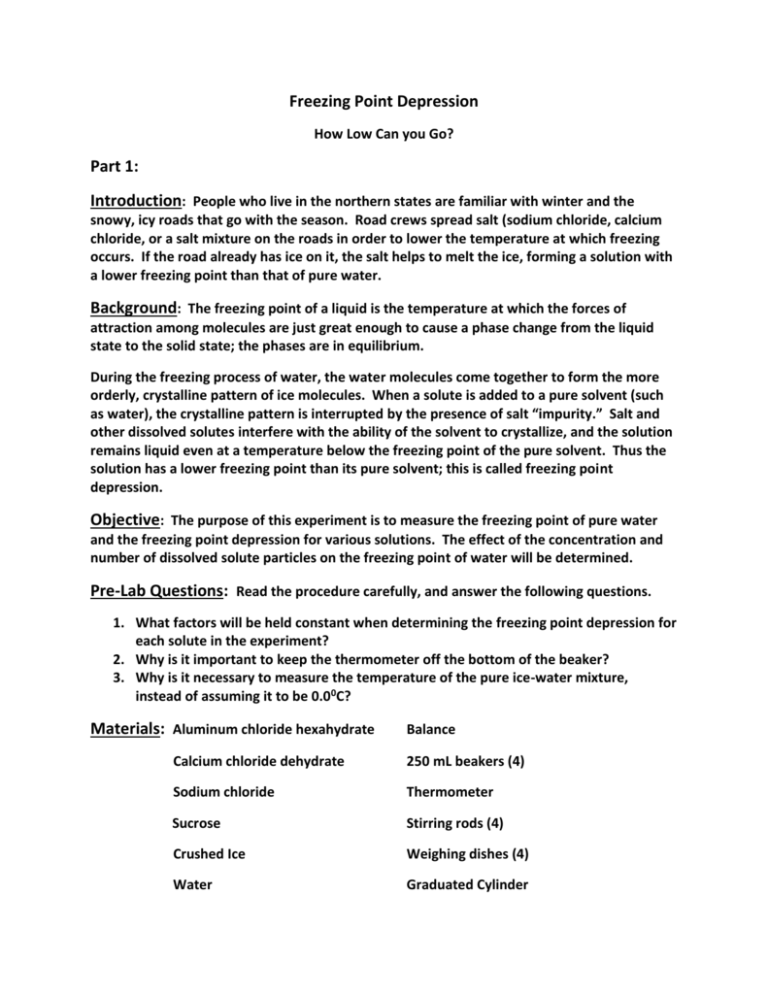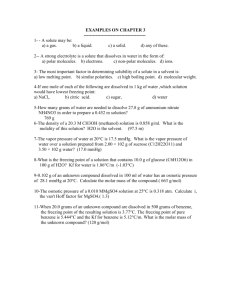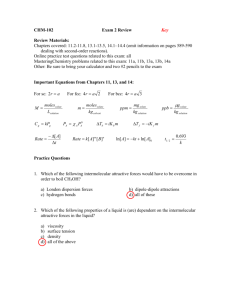Freezing Point Depression Lab
advertisement

Freezing Point Depression How Low Can you Go? Part 1: Introduction: People who live in the northern states are familiar with winter and the snowy, icy roads that go with the season. Road crews spread salt (sodium chloride, calcium chloride, or a salt mixture on the roads in order to lower the temperature at which freezing occurs. If the road already has ice on it, the salt helps to melt the ice, forming a solution with a lower freezing point than that of pure water. Background: The freezing point of a liquid is the temperature at which the forces of attraction among molecules are just great enough to cause a phase change from the liquid state to the solid state; the phases are in equilibrium. During the freezing process of water, the water molecules come together to form the more orderly, crystalline pattern of ice molecules. When a solute is added to a pure solvent (such as water), the crystalline pattern is interrupted by the presence of salt “impurity.” Salt and other dissolved solutes interfere with the ability of the solvent to crystallize, and the solution remains liquid even at a temperature below the freezing point of the pure solvent. Thus the solution has a lower freezing point than its pure solvent; this is called freezing point depression. Objective: The purpose of this experiment is to measure the freezing point of pure water and the freezing point depression for various solutions. The effect of the concentration and number of dissolved solute particles on the freezing point of water will be determined. Pre-Lab Questions: Read the procedure carefully, and answer the following questions. 1. What factors will be held constant when determining the freezing point depression for each solute in the experiment? 2. Why is it important to keep the thermometer off the bottom of the beaker? 3. Why is it necessary to measure the temperature of the pure ice-water mixture, instead of assuming it to be 0.00C? Materials: Aluminum chloride hexahydrate Balance Calcium chloride dehydrate 250 mL beakers (4) Sodium chloride Thermometer Sucrose Stirring rods (4) Crushed Ice Weighing dishes (4) Water Graduated Cylinder Safety Precautions: Avoid contact of all chemicals with eyes and skin. Wash hands thoroughly with soap and water before leaving the lab. Procedure: Form a working group of 4 students. Each pair will measure the freezing point of water with their thermometers (steps 2-6), and then determine the freezing point depression for two of the solutes. Both pairs of students in each group will share their data and complete the data table and questions. 1. Label four 250 mL beakers #1-4. 2. Add approximately 100.0 grams of ice-water mixture to the beaker by (a) first adding 70-80 grams of crushed ice and (b) enough water so the total mass of the ice-water mixture is approximately 100.0 grams. Note: If the balance does not have a large enough capacity, weigh the ice in a weighing dish; measure the remaining water using a balance or graduated cylinder. 3. Stir the ice-water mixture. Wait for the temperature to stabilize and record the temperature to the nearest tenth of a degree. Beaker #1 – Sodium Chloride 4. Weigh approximately 30.0 grams of sodium chloride and record the mass. 5. Add the sodium chloride to the ice water mixture in beaker #1; stir until slushy. 6. Stir the contents of the mixture while recording the lowest temperature obtained before the temperature of the mixture starts to rise again. Beaker #2 – Sucrose 7. Repeat steps 2 – 6 for Beaker #2, using 100.0 grams of ice water and 30.0 grams of sucrose. Beaker #3 – Calcium Chloride Dihydrate 8. Repeat steps 2 – 6 for beaker #3. Beaker #4 – Aluminum Chloride Hexahydrate 9. Repeat steps 2 – 6 for beaker #4. Data Table: Beaker Number Solute Mass of Ice and Water Mass of Solute Freezing Point of Water Lowest Temperature of Mixture Post-Lab Calculations: Show All Work 1. Determine the molar mass of each solute and calculate the number of moles of each solute. 2. Calculate the experimental value of the freezing point depression for each solute. 3. Calculate the ∆Tf per mole of solute. 4. Write balanced dissociation reactions for all that apply, and determine the ΐ for each solute. 5. Calculate the concentration, molality, of each solution. 6. Determine the theoretical value of the freezing point depression for each solute based on the molality of the solution and the ideal number of solute particles (ΐ). 7. Compare the experimental and theoretical values of ∆Tf for each solute. Discuss possible sources of error in your conclusion. 8. Which solute has the greatest freezing point depression per mole? Which had the least? Is this what would be expected? 9. Prepare a graph of∆Tf / mole on the y-axis versus ΐ on the x-axis. Describe the relationship shown by the graph. Results Table: Beaker Number Solute Molar Mass Moles of Solute ∆Tf (exp) [∆Tf(exp)]/ mole Ϊ (ideal) m ∆Tf (theor) 1 NaCl 2 C12H22O11 3 CaCl22H2O 4 AlCl36H2O Extension: Given the following cost data, determine which would be the most effective and which is the most cost effective for preventing road icing. Justify your answer including what possible damage the chemical can cause to the roads and the environment. Solute Sodium Chloride Sucrose Calcium Chloride Aluminum Chloride Cost/kg $ 0.64 $0.79 $0.77 $2.76 Part 2: Data to be given in class for determining the molar mass of a solute using freezing point depression.







